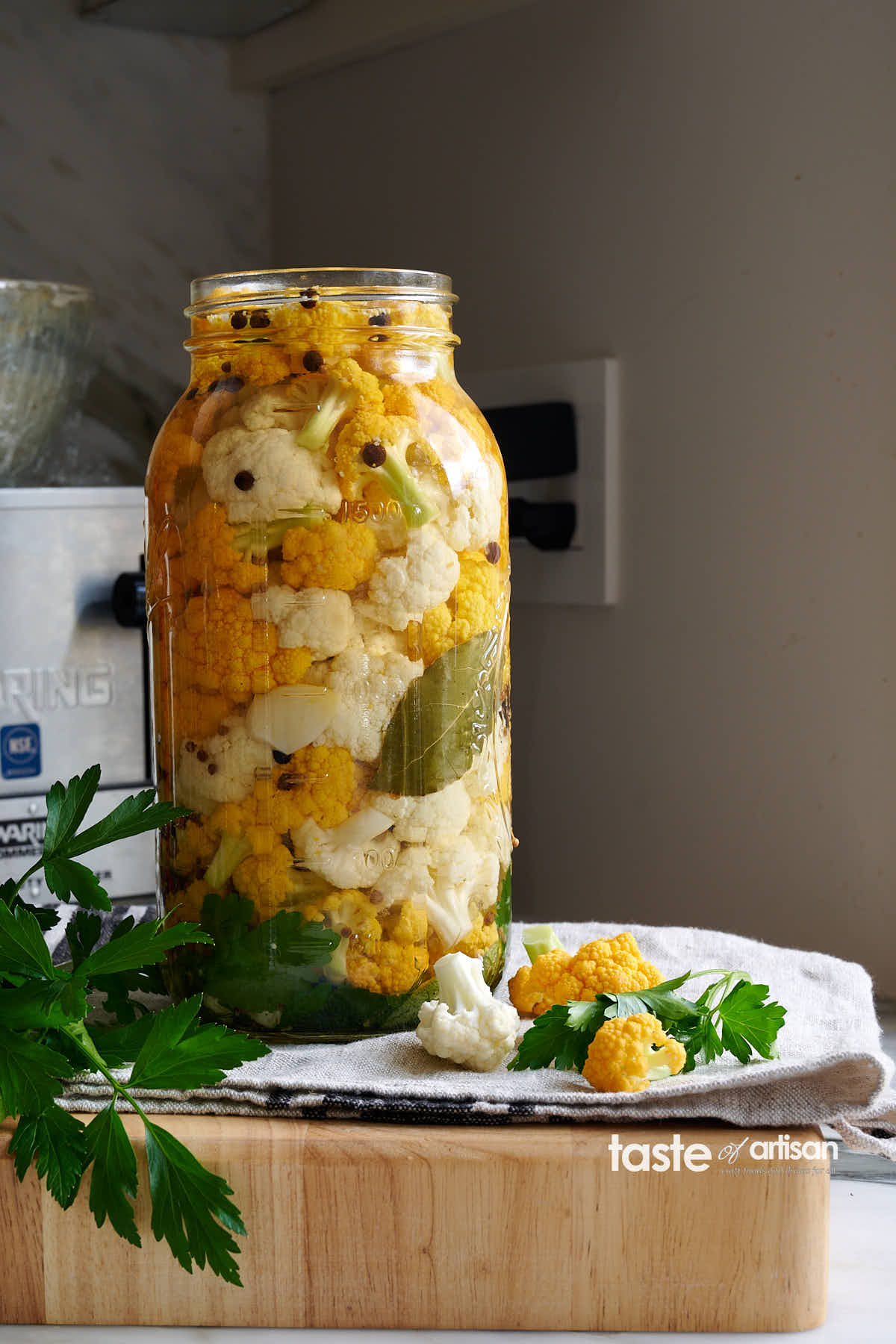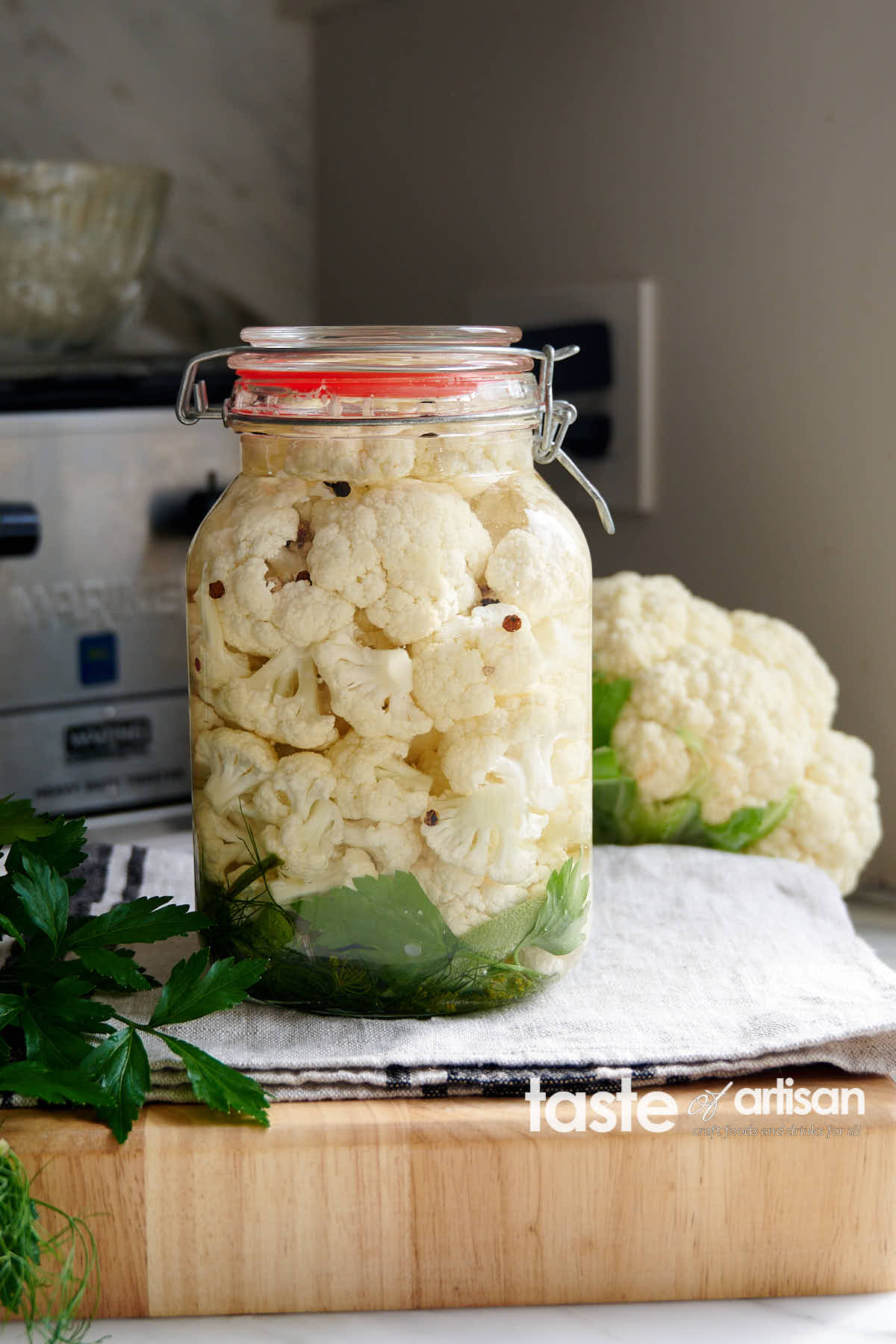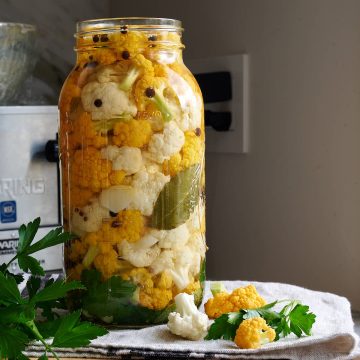This is one of my favorite ways to make pickled cauliflower. The vegetables are covered with a delicious, lightly sweet and sour pickling brine and refrigerated for a week. I love the resulting crunchy texture coupled with a gentle bite of acidity, a touch of sweetness, and a hint of aromatic herbs and spices. It goes so well with hearty fall and winter dishes. I eat it as a snack, too. I think it's quite delicious on its own.

I adapted this recipe with a few changes from the Charcuterie: Pâtés, Terrines, Savory Pies book written by the famous Ferrandi School of Culinary Arts in Paris. If you are into French cuisine, especially their charcuterie, this book is a must-read.
While I generally liked the original recipe, I found the amount of sugar used in it overwhelming, so I cut it in half, which made the brine much more palatable for my taste. I also substituted some aromatic spices and herbs to suit my taste. I think the resulting recipe is exceptionally delicious, but feel free to experiment with your own aromatic components. The options here are endless.

What I like the most about this pickled cauliflower recipe is that it uses less vinegar than most recipes that I've come across. It creates a very balanced pickling brine with gentle acidity and sweetness and a lot of aromatic flavors from herbs and spices.
Cauliflower
Cauliflower will keep fresh for a week or two after harvest. It's best to pickle it within that timeframe! If you have ever tried to grow cauliflower yourself, you know how fussy it is, so we want to preserve every last bit of it. Making pickled cauliflower is one of the best ways to preserve and enjoy it.
Cauliflower heads vary widely in size and weight. The rule of thumb is that a trimmed cauliflower (leaves and stem removed) that weighs one pound yields four cups of florets. This is roughly equivalent to a 6"-diameter head.
Spices and herbs
My favorite spices are black or multi-color peppercorns, coriander, and allspice. I've also experimented with mustard seeds, nutmeg, whole cloves, and cinnamon. These are also great options.
The herbs add brightness and another layer of aromatics. The original recipe uses thyme, which I like, but it's not my favorite herb. Instead, I use a combination of parsley, sage, and dill. Oregano and cilantro are also very good options. Use what you have on hand because it will be simpler, and those will likely be your favorite herbs anyway.
Making the brine
Combine water, salt, vinegar, and sugar in a saucepan. Add the garlic, peppercorns, coriander seeds, and allspice berries. Bring to a boil.
I do not add the herbs at this stage as I want them to remain brightly colored. Do not worry; they will transfer most of their aroma to the brine during brining.
Pickling
Pour the hot brine over the cauliflower, close the jar with a lid, and let it cool to room temperature. Then, refrigerate for one week before enjoying your delicious pickled cauliflower.
Serving and storage
This cauliflower is very good on its own as a snack, but it also goes so well with hearty fall and winter dishes. I like it with grilled or BBQ meats.
Refrigerated, it will last for a month, even longer.
Enjoy!

Ingredients
- 8 cups bite-size cauliflower florets
- 2 1/2 cups water 600 ml
- 1 1/4 cups white vinegar 300 ml
- 3 1/3 tsp kosher salt 20 g
- 5 Tbsp white sugar 60 g
- 2 cloves garlic
- 1 Tbsp peppercorns black or a mix of black, white, and red
- 1 Tbsp coriander seeds
- 1/2 Tbsp allspice berries
- 2 bay leaves
- A few twigs of fresh herbs parsley, dill, thyme, oregano, sage, etc.
Instructions
- Soak the cauliflower in water for 15 minutes, cut it into bite-size pieces, rinse well, and drain.
- Rinse a few twigs of fresh herbs, whatever you like or have on hand, and drop to the bottom of a 2-qt pickling or canning jar.
- Next, pack the cauliflower (somewhat tightly) in the jar and set aside.
- Prepare the pickling brine by combining water, salt, sugar, and vinegar in a saucepan, adding garlic, peppercorns, coriander seeds, bay leaves, and allspice berries. Bring the brine to a boil and turn off the heat.
- Immediately pour the brine into the jar; transfer the spices, bay leaves, and garlic. See notes.
- Close the jar with a lid and refrigerate for one week before enjoying. Keep refrigerated.
Notes
Nutrition


Brenda says
Hi Victor, what size jar are you using here?
Victor @ Taste of Artisan says
Brenda, it's a 2qt jar in the picture.
Steve says
Victor, can this recipe be canned?
Victor @ Taste of Artisan says
Hi Steve, no, this one is not even close to the USDA approved recipe for canning cauliflower, if what you are looking for is an approved safe recipe. USDA recommends canning in a brine that is a mix of 5% vinegar and sugar, no water. You can find the recipe here - https://pubs.nmsu.edu/_e/E318/. But the taste will be very different. Which is why I now mostly pickle/ferment and refrigerate in an old dedicated fridge I have in the basement. You can always pressure can, but the texture will be ruined.
Steve says
Thanks Victor. Sort of what I thought. It just sounded like a nice blend of flavours so I was hoping it would work.
On another note, I put down my first large batch of 5% canning pickles today and a couple of jars of 3.5% pickles. I found a great pickling jar on line. It has an extra wide mouth and a lid prefitted with a whole for the air lock. It also came with the air locks. It holds 1.6 gallons, so almost the perfect size for a batch. It came in a two pack.
Victor @ Taste of Artisan says
Yeah, I wish we could. Lot's great pickling recipes but you can't can them. Only refrigerate.
Great to hear about you starting your pickling. It's that time of the year... My pickling cucumbers started to pick up and I began to pickle a little at a time as well. For low salt pickles, I use these 5L Italian pickling jars my wife once found in a local store. Maybe we are using the same jars. These are fantastic. I don't even use air locks with them. I close the lids and purge CO2 gas once a day. Works like a charm. Here it is. The jar is not full yet, but I wanted to pickle them as soon as they got off the vine yesterday. I will add more today or tomorrow morning to fill it all the way up.